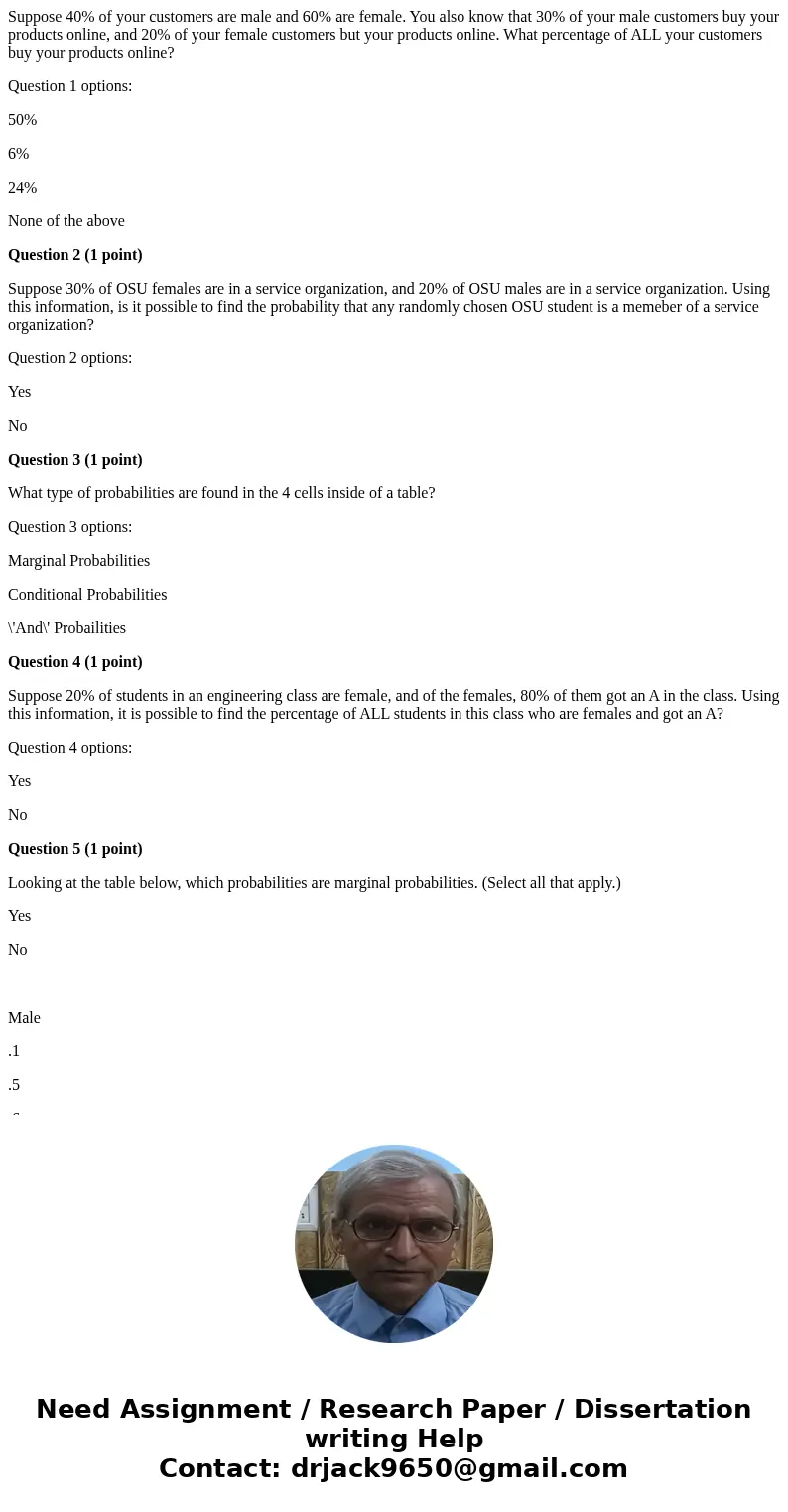Suppose 40 of your customers are male and 60 are female You
Suppose 40% of your customers are male and 60% are female. You also know that 30% of your male customers buy your products online, and 20% of your female customers but your products online. What percentage of ALL your customers buy your products online?
Question 1 options:
50%
6%
24%
None of the above
Question 2 (1 point)
Suppose 30% of OSU females are in a service organization, and 20% of OSU males are in a service organization. Using this information, is it possible to find the probability that any randomly chosen OSU student is a memeber of a service organization?
Question 2 options:
Yes
No
Question 3 (1 point)
What type of probabilities are found in the 4 cells inside of a table?
Question 3 options:
Marginal Probabilities
Conditional Probabilities
\'And\' Probailities
Question 4 (1 point)
Suppose 20% of students in an engineering class are female, and of the females, 80% of them got an A in the class. Using this information, it is possible to find the percentage of ALL students in this class who are females and got an A?
Question 4 options:
Yes
No
Question 5 (1 point)
Looking at the table below, which probabilities are marginal probabilities. (Select all that apply.)
Yes
No
Male
.1
.5
.6
Female
.2
.2
.4
.3
.7
1
Question 5 options:
.2
.6
.4
None are marginal probabilities
Question 6 (1 point)
Looking at the table below, which probabilities are \'and\' probabilities. (Select all that apply)
Yes
No
Male
.1
.5
.6
Female
.2
.2
.4
.3
.7
1
Question 6 options:
.7
1
.5
None of the above are \'and\' probabilities.
Question 7 (1 point)
Looking at the table below, which probabilities are conditional probabilities.
Yes
No
Male
.1
.5
.6
Female
.2
.2
.4
.3
.7
1
Question 7 options:
.2
.4
.1
None of the above are conditional probabilities
Question 8 (1 point)
If two events C and D are independent then P(C or D)=P(C)+P(D)-P(C)*P(D)
Question 8 options:
True
False
Question 9 (1 point)
If P(A and B)=0, P(A)=0.20, P(B)=0.80, then A and B are
Question 9 options:
Independent
Disjoint
Not possible for this to happen
Question 10 (1 point)
Suppose you know the probability that someone owns their own home is .6, and you know the probability that someone owns a car, given they own their own home is .8. Let H=owns their own home and C-owns their own car. Using the above information, what is the probability someone owns their own home, given they own their own car?
Question 10 options:
.8
.2
.48
None of the above, or cannot be determined.
| 50% | |
| 6% | |
| 24% | |
| None of the above |
Solution
(1) 0.4*0.3+0.6*0.2 = 0.24
Answer: 24%
----------------------------------------------------------------------------------------------------------------------
(2)Yes
----------------------------------------------------------------------------------------------------------------------
(3)\'And\' Probailities
----------------------------------------------------------------------------------------------------------------------
(4)Yes
----------------------------------------------------------------------------------------------------------------------
(5).6 and .4
----------------------------------------------------------------------------------------------------------------------
(6).5
----------------------------------------------------------------------------------------------------------------------
(7).2 and .1
----------------------------------------------------------------------------------------------------------------------
(8)True
----------------------------------------------------------------------------------------------------------------------
(9)Disjoint
----------------------------------------------------------------------------------------------------------------------
(10) Given P(Home)=0.6
P(Car|Home)=0.8
--> P(Car and Home)/P(Home)=0.8
--> P(Car and Home) = 0.8*0.6=0.48
So P(Home| Car) = P(Car and Home)/P(Car) = 0.48/P(car) which is not given.
Answer: None of the above, or cannot be determined.





 Homework Sourse
Homework Sourse